A persistent hybrid from Japanese breeders - tomato "Michelle f1": we grow ourselves without hassle
Michelle f1 hybrid tomato was created by Japanese breeders. However, the popularity of culture has crossed the borders of the Land of the Rising Sun - the hybrid is grown not only in Russian beds, but also in neighboring countries.
High yield and great taste of fruits are the main, but not the only advantages of tomato. Ripe vegetables are in great demand in the sales markets, so they are bred not only for personal use, but also on an industrial scale.
The content of the article
Characteristics and description of tomato
The hybrid was bred by Japanese breeders from the Sakata company. Recommended for breeding under a film cover.
reference! The Japanese company Sakata has been breeding for over 100 years, since 1913. It has over 10 of its own stations and research laboratories on 5 continents of the world.
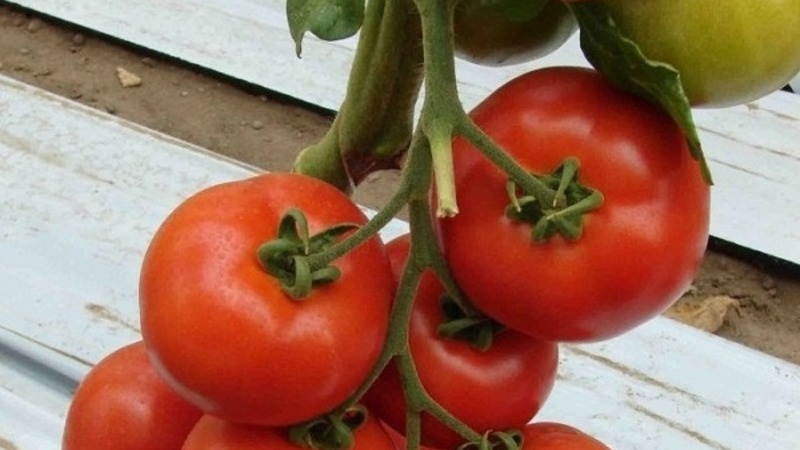
Distinctive features
A type indeterminate, grows more than 2 m, since the growth of the main stem is not limited. The root system is compact, which allows planting up to 5 plants per 1 m2. The foliage is dense, the stem is powerful. On each bush, 8–10 fruitful clusters are formed, which tie 5–7 fruits.
Tomato is resistant to a number of diseases: verticillium, fusarium, tobacco mosaic virus and root nematode.
reference! Nematodes are representatives of a large group of roundworms that parasitize animals and plants. In a short period of time, they are capable of destroying all plantings.
Ripening periods are average: the first fruits are harvested 100-110 days after sowing the seeds. The ovaries are formed in all weather conditions.
The yield is high: up to 15 kg of fruits are harvested from 1 m2.
Without additional support, the stem will not support the weight of heavy fruit-bearing branches, so a garter of plants is necessary. Also, seedlings need pinching and shaping.
Fruit characteristics
Ripe vegetables are roundish, bright red, average weight ranges from 140 to 220 g. 3-4 seed chambers. The pulp is dense, which complicates the preparation of freshly squeezed and canned juices.
The taste is sweet, sugary, pronounced. The peel is dense, so the vegetables are stored for a long time and retain their presentation when transported over long distances. For these reasons, the culture is bred on an industrial scale.
The use of tomatoes is universal: they are not only ideal for preparing fresh dishes, but also do not lose their taste in winter preparations. The size of the fruits allows them to be preserved whole.
The photo shows Michelle f1 tomatoes.
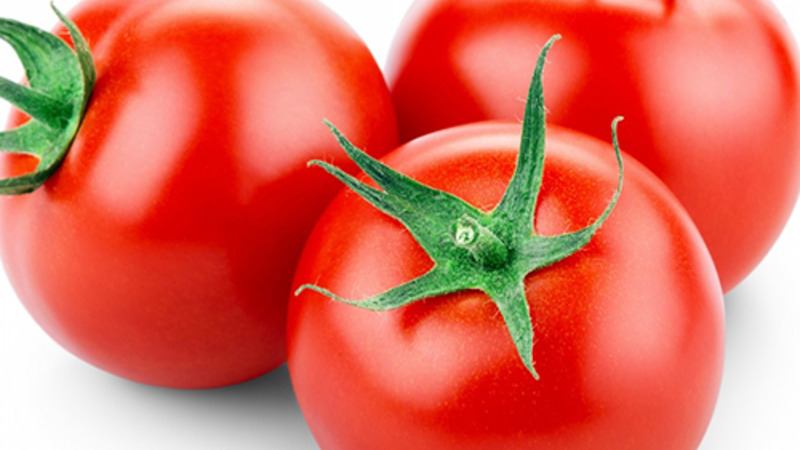
How to grow seedlings
Before you start sowing seeds, you need to prepare the container, soil and the planting material itself. The preparation is mainly about disinfection, as it determines the healthy growth of the seedlings.
Seed preparation
The seed fund of hybrid crops does not preserve genetic memory, so it makes no sense to harvest grains for planting yourself: the grown fruits will noticeably deviate from the declared qualities. Therefore, the material will have to be bought every time.
Purchased seeds are pre-treated, so disinfection is not required. However, to strengthen the immunity of the grain, you can hold it for 20 minutes in a weak solution of potassium permanganate, and then leave it for 10 hours in a growth stimulator.This increases the germination rate. From stimulants used "Epin" and "Kornevin".
Capacity and soil
The soil for sowing is prepared universal: from garden soil, peat and humus. For looseness, add a little river sand. To saturate the soil with useful substances, wood ash is added. It also reduces acidity, which has a beneficial effect on the growth of any tomato crop.
After mixing all the components, the resulting mixture is poured with a hot strong solution of manganese. Soil disinfection is carried out to destroy pathogenic flora.
The containers, like the ground, are treated with a strong manganese solution, especially if these containers have already been used for planting: surviving disease-causing spores can cause great damage to seedlings.
At the bottom of each container, drainage holes are made to drain excess moisture. In the absence of drainage, excess fluid will have a detrimental effect on young roots.
You can plant it in a common wooden box and in individual plastic or peat cups.
Sowing
The seeds are buried 1.5–2 cm with a distance between the grooves of 3 cm. The temperature in the room where the containers will be located must be at least +22 ° C. After sowing, the soil is moistened with warm, settled water and covered with foil. When creating a greenhouse effect, the grains will germinate faster.
Before emergence, containers are left in a bright room.
Seedling care
After the emergence of seedlings, the film is removed, the containers are placed on the windowsill. It is important to provide the seedlings with 16 hours of light. With a lack of it, the seedlings will stretch and weaken. To prevent this, lamps are additionally installed.
Watered as the top layer of the soil dries up with warm, settled water from a shallow watering can. After that, the soil is superficially loosened: with deep loosening, there is a high probability of disrupting the root system.
When 2 true leaves appear, a pick is carried out, seating the seedlings in separate cups. This allows plants to develop more intensively due to the growth of lateral roots.
With poor growth, a week after the pick, the seedlings are fed with liquid fertilizer for seedlings. The same feeding is carried out before planting in the ground.
Seedlings must be hardened 10 days before planting in the ground. To do this, it is taken out into the open air for 1 hour in the daytime. The time spent on the street is gradually increased to 9 hours.
How to grow tomatoes
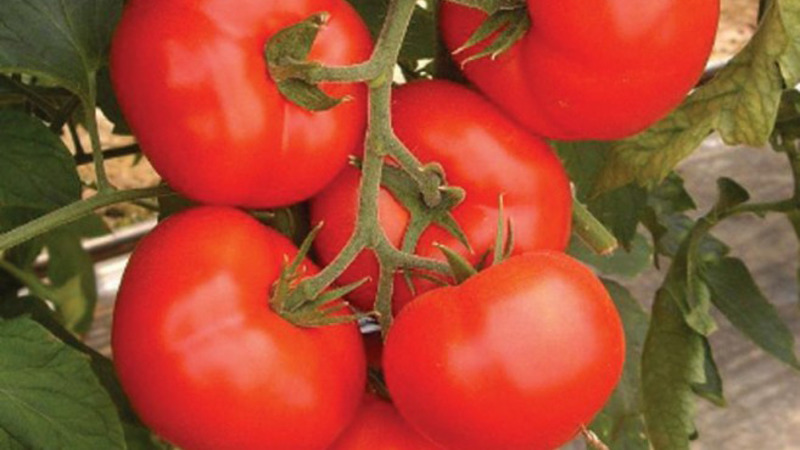
Before planting seedlings in the ground, it is dug up and a full range of minerals is introduced.
Landing
The compact root system makes it possible to plant up to 5 seedlings per 1 m2. A little sawdust or ash is placed in each hole 15 cm deep, which is poured over with warm water.
The transplant is done on a cloudy day or in the evening. The seedlings are buried to the first leaves, compact the earth and irrigate with warm water. While young bushes are getting used to new conditions, the soil is not moistened for a week.
Further care of Michelle's tomato
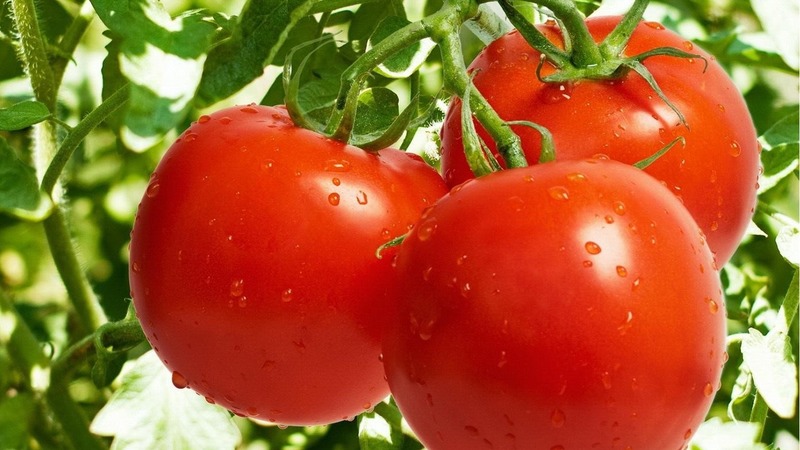
The hybrid is picky about watering and feeding... These are the necessary conditions for its full development.
Water abundantly, as the upper soil layer dries up. However, it is not necessary to fill in the seedlings: from excess moisture, root rot is possible. So that the beds do not dry out longer, they are mulched with peat or straw.
Loosening after irrigation ensures the air permeability of the soil. The oxygen supplied to the roots strengthens the plant's immunity.
The weed takes from the soil a lot of nutrients necessary for the growth of the seedlings, so weeding is a must. In addition, spores of fungi and many pests that are dangerous for crops of the Solanaceae family multiply in weeds, therefore, proximity to weeds is highly undesirable.
A full range of minerals is added from the dressings.After transplanting, fertilizer is used with a predominant nitrogen content, during flowering, phosphorus is added instead of nitrogen, and at the time of fruiting, potassium substances are added.
The culture is fed once every 2 weeks. All top dressing is combined with watering.
Features of care and possible difficulties
Without garters the stem cannot bear the weight of the fruit-bearing branches. Therefore, next to each seedling, supports are installed, to which the stem and branches are fixed. It is also possible to tie on a trellis. Between the supports installed on different sides of the beds, a wire is pulled horizontally, to which the plants are tied with synthetic material.
To get the most out of it, it is recommended to form a 1-stem bush. All other stepchildren are removed at intervals of 1 every 10 days. To avoid thickening of the plantings, remove all the lower leaves.
Stealing carried out early in the morning so that by the evening all the wounds have time to heal. Places of cuts are sprinkled with ash, ensuring disinfection.
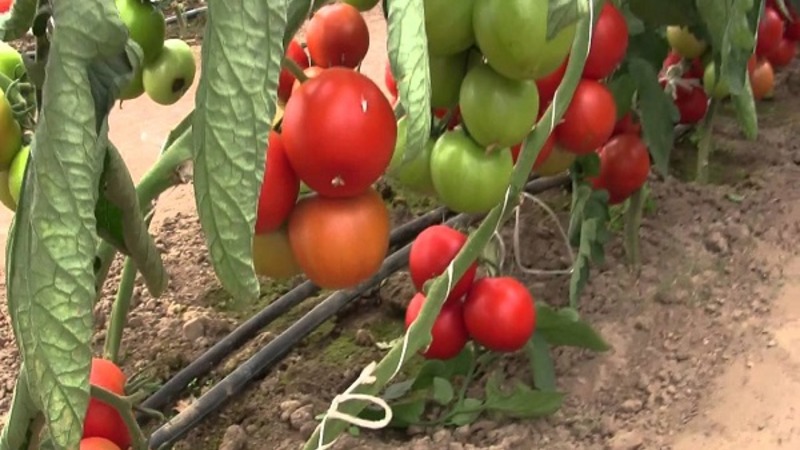
Diseases and pests
The genes of the hybrid have a good resistance to diseases, due to which it is immune to many infections. However, do not forget about the prevention and enhancement of the immunity of seedlings.
Subject to moderate watering, regular loosening, weeding and timely fertilization, not only full development takes place, but also the strengthening of protective forces.
Before planting, the earth is spilled with a hot solution of manganese and treated with copper sulfate, thereby destroying fungal spores. This is especially important when growing tomatoes in a greenhouse.
If crops from the Solanaceae family grow next to tomatoes, it is necessary to regularly spray all plants with fungicidal agents. The drug "Fitosporin" has an effective prophylactic effect.
Of the pests, butterflies (more precisely, their caterpillars) whitefly and scoop are dangerous. In the fight against whitefly use the drug "Confidor" or folk remedies (for example, planting basil, calendula and marigold next to tomatoes). Herbs with their smell scare away pests from the beds.
The smell of calendula scares off not only the whitefly, but also scoop... You can also spray the plants with a decoction of onion peels. From chemicals used "Karate" or "Decis".
reference! The scoop is omnivorous. It destroys not only tomatoes, but also cabbage, beets, peppers and eggplants.
The nuances of growing in an open field and a greenhouse
The culture is recommended for breeding under a film shelter, however, residents of the southern regions successfully grow it in the open field. In more severe weather conditions, the tomato grows in heated greenhouses. Regardless of external factors, taste and quantity are maintained at the proper level.
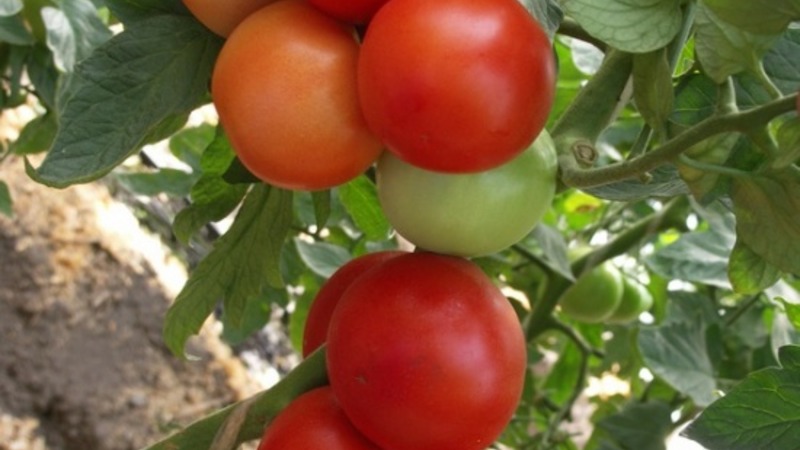 To limit the growth of the main stem, the crown of the plants is pinched. After that, all the forces of the bush are spent on the formation of fruits, and not on further growth.
To limit the growth of the main stem, the crown of the plants is pinched. After that, all the forces of the bush are spent on the formation of fruits, and not on further growth.
Closed structures must be ventilated on a daily basis. This maintains the humidity and temperature indicators within normal limits, which prevents the development of fungal diseases. In addition, fresh air destroys the habitual habitat of the main greenhouse pest - the spider mite.
Harvesting and application of the crop
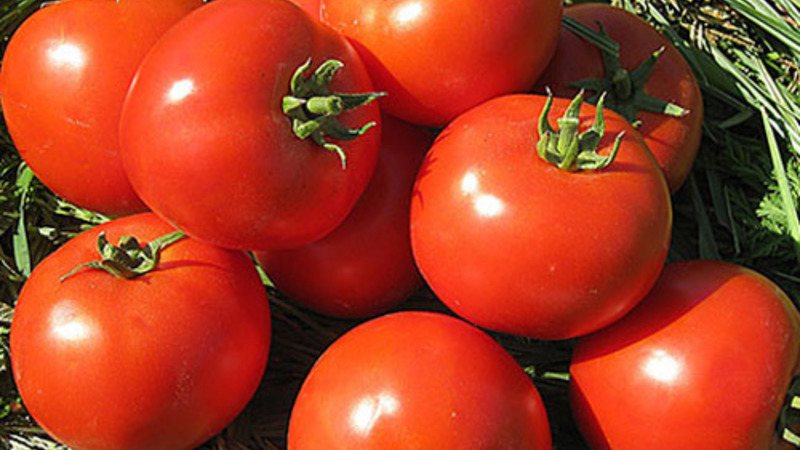
Vegetables ripen in the middle of the summer season. They are not allowed to overdue. The harvest on time retains its presentation for a long time, and the bush is unloaded for the development of the next tomatoes.
Ripe vegetables are transported to any distance without losing their appearance and taste.
In cooking, the fruits of the hybrid have found universal application. They are used for all kinds of fresh dishes and for winter preparations. Smooth, brightly colored tomatoes look great in glass jars for whole-fruit canning.
Advantages and disadvantages of a hybrid
Due to its many positive qualities, the tomato is highly valued among gardeners. He possesses:
- unpretentiousness to climatic factors;
- the formation of ovaries in any weather;
- uncomplicated agricultural technology;
- high rate of fruiting;
- resistance to many diseases;
- great taste;
- marketable form;
- long-term storage and transportation capabilities;
- universal application.
The disadvantages include the need for pinching and garter plants. Here you can add the purchase of seeds for each planting.
Farmers reviews
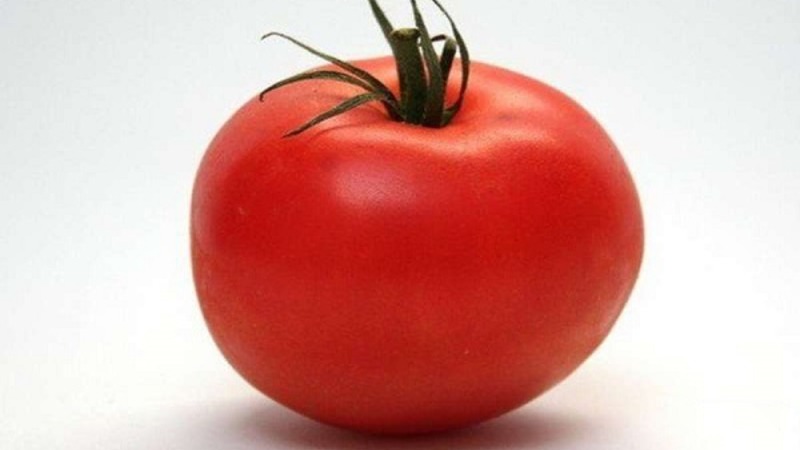
Numerous reviews speak of the reliability of the culture. For most farmers, Michelle f1 brings substantial profits:
Veronica, Tambov: “The hybrid bears great fruit. The tomatoes are juicy, aromatic and sweet. They are good in salads and in canning, but not juicy enough for tomato juice. I especially liked the fact that the seedlings do not get sick at all, although they require regular feeding and watering. I can't say that leaving is difficult, rather the opposite. So I recommend everyone to try it. "
Evgeniy, Saratov: “Before I found my favorite taste, I tried many varieties. I like the tomato with its high yield and easy care. I plant in large quantities, some are for sale. Winter preparations from vegetables are excellent, very tasty and have a long shelf life, like fresh tomatoes. "
Conclusion
Japanese hybrid Michelle f1 allows you to collect from 1 m2 to 15 kg of excellent fruits. The universal use of ripe vegetables does not allow them to stay on store shelves for a long time. The hybrid is immune to tomato diseases and easy to care for.
Thanks to these qualities, he fell in love with many gardeners in various regions. In a word, the guest from Japan continues to conquer Russian areas, winning places of honor in the garden plots.